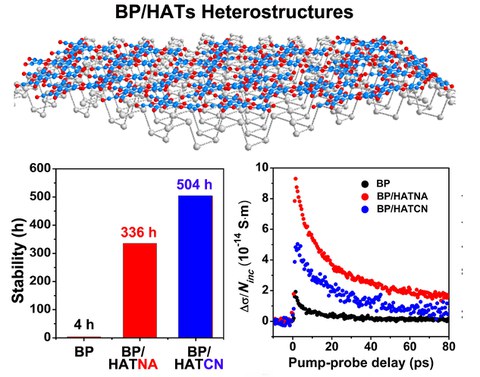Sep 24, 2021
Molecularly Engineered Black Phosphorus Heterostructures with Improved Ambient Stability and Enhanced Charge Carrier Mobility
Black phosphorus (BP) is an attractive layered semiconductor owing to a widely tunable bandgap (from 0.3 eV in bulk to 2 eV in the monolayer), inherent in-plane anisotropy, appealing charge-carrier mobility (1000 cm2 V-1 s-1) as well as a broadband absorption from visible to mid-infrared range. All these features enable broad applications of BP in many fields, such as field-effect transistors (FETs), optoelectronic devices, energy conversion, energy devices. However, BP is highly vulnerable to oxygen and moisture due to abundant lone pair electrons at the BP surface. To address this problem, various chemical functionalization methods have been implemented to protect the BP sheets from oxidation. For example, covalent functionalization is an effective method to protect the topological structure of BP sheets. However, this strategy directly break P-P bonds thus largely compromise BP’ electronic properties. In contrast, non-covalent functionalization can preserve or modify the intrinsic properties of BP sheets to a large extent. However, it is generally less effective to regulate electronic properties of BP because of the weak interfacial coupling.
The researchers from the group of Prof. Xinliang Feng in collaboration with the group of Prof. Mischa Bonn (Max Planck Institute for Polymer Research) and Dr. Hai I. Wang (Max Planck Institute for Polymer Research) demonstrate an organic–inorganic hybrid heterostructure to enhance the stability of BP sheets and to tune simultaneously their electronic properties using hexaazatriphenylene derivatives (HATs). As electron acceptors, HATs can withdraw lone pair electrons from P atoms, resulting in a strong charge transfer from BP surface to HAT layer and leading to an improved ambient stability of BP/HATs sheets for up to 21 d. THz spectroscopic studies reveal that HATs substantially extend the scattering time of BP/HATs and yield a charge carrier mobility of 97 cm2 V-1 s-1 for BP/HATs film, which is much higher than that of the pristine BP film (35 cm2 V-1 s-1). The strategy opens up new avenues for versatile applications of BP sheets and provides an effective method for tuning the physicochemical properties of other air-sensitive 2D semiconductors.
Reference: Huanhuan Shi, Shuai Fu, Yannan Liu, Christof Neumann, Mingchao Wang, Haiyun Dong, Piotr Kot, Mischa Bonn, Hai I. Wang, Andrey Turchanin, Oliver G. Schmidt, Ali Shaygan Nia, Sheng Yang, Xinliang Feng. Molecularly Engineered Black Phosphorus Heterostructures with Improved Ambient Stability and Enhanced Charge Carrier Mobility, Adv. Mater. 2021, 2105694,
https://onlinelibrary.wiley.com/doi/10.1002/adma.202105694
Acknowledgments: This work was financially supported by Deutsche Forschungsgemeinschaft (MX-OSMOPED project), ERC Consolidator Grant on T2DCP, M-ERA-NET project HYSUCAP, SPES3 project funded by German Ministry for Education and Research (BMBF) under Forschung für neue Mikroelektronik (ForMikro) program and GrapheneCore3 881603. The authors thank Dr. Panpan Zhang, Dr. Zaichun Liu, Dr. Libo Ma, Dr. Kejun Liu, Dr. Haoyuan Qi, Dr. Zhen Zhang, and Dr. Markus Löffler for helpful discussions and characterization, and also acknowledge the Center for Advancing Electronics Dresden (cfaed), the Dresden Center for Nanoanalysis (DCN). Y.L. also acknowledges the Centre for Information Services and High Performance Computing (ZIH) in Dresden, Germany, for the provided computational resources. In addition, the authors acknowledge the support of computational calculations from Chenghao Liu in McGill University, Canada. H.S. and S.F. thank China Scholarship Council (CSC) for financial support. C.N. and A.T. acknowledge the financial support by FLAG-ERA “H2O” Project (DFG TU149/9-1) and SPP 2244 “2DMP” (DFG TU149/13-1).

